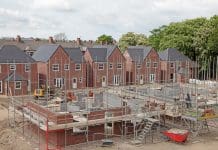Planning and building regulations allow developers to make bad technical decisions. David Frise, Head of Sustainability, BESA, has an alternative approach
When a developer puts in a planning application, they are, in effect, making a promise to the local community to deliver the building that is designed and that it complies with regulations. They should not be able to break that promise; but the currently flimsy enforcement regime allows them to – time and time again.
This is not a ‘victimless crime’. As a result of this ‘performance gap’, taxpayers have to finance expensive power generation projects, such as Hinkley C, to keep sustaining these energy inefficient and poorly designed buildings; while watching as the developers and their investors reap handsome rewards at our expense.
However, there is a way to reshape the planning system so that the developer actually delivers the project they promised, but it requires a new form of ‘social’ contract between the developer and the people ultimately affected by what they want to build.
With a few notable exceptions, most developers are not concerned about the final outcome or the long-term performance of their building because they are not picking up the energy bills and, whatever they do, the value of their saleable asset increases. Their primary focus is on a return on investment (ROI) and that requires delivering the project to budget and on time. As a result, most local communities dread having major construction work taking place in their area because it is disruptive, unpleasant and invariably lasts far longer than forecast.
Vision
This is also because the initial vision has little to do with what ultimately gets built. It is the developer’s need for a rapid ROI that drives behaviour down the supply chain.
Contractors start work on site with precious little design information because the project is going through the process of ‘value engineering’, which is another way of describing a process that consists of buying products at the cheapest possible price and then putting them together in something that only approximates the original design. The building may well look the same, but in performance terms, it will be way out – often by a shameful 400% regarding energy consumption.
If you put a car together like that; it probably wouldn’t be drivable, and certainly would break down all the time. The car industry focuses on the final product and has succeeded in transforming their reputation as a result.
Construction is an activity-based industry, generally triggered by the payment system, which means it gets people and materials to site as fast as possible. As a result, the ‘team’ stumbles into a ‘build and design’ pattern that means the people on site are making things up as they go along – taking too long and making lots of short term decisions with long term implications.
To tackle this systemic problem, the local authority should only grant planning approval to the developer on the proviso that no work can start on site until a very large proportion of the design is complete and signed off – say 75%. A professional employed by the developer would provide the verification, and a new British Standard might be appropriate to gain consistency. The developer still has the security of knowing the project can progress, but this compels them to ensure the project is properly designed first.
The emergence of Building Information Modelling/Management (BIM) means we now have a tool to support this new form of contract because it allows for early and low-cost verification of designs as well as transparency of the process.
This makes it possible for the local planning department to operate more like the Civil Aviation Authority. Can you imagine Boeing starting to build an aircraft before it was fully designed? Would such a craft ever get off the ground?
The Building Regulations also need a thorough shake-up. Part L, in particular, encourages a ‘tick box’ mentality and a wholly unimaginative approach to building design that is condemned to fail before it even starts. This applies just as much to the refurbishment of existing buildings as new projects.
Part L calculations are not energy performance metrics because they use arbitrary or standardised data in a bid to come up with a simple equation. Variables like dynamic weather conditions and unregulated energy usage, which in many cases accounts for over 60% of total energy consumption, are simply ignored. There is also very little possibility of reflecting how the building is to be used and operated in the simplistic terms of Part L.
Hopeless
The standardised design data it relies on is also completely hopeless for calculating how complex building services systems are likely to operate under real conditions and over time. It is difficult (impossible even) to determine what the ‘performance gap’ is because you are not designing for performance, but simply aiming for the lowest common denominator that gets you over the line for compliance and planning consent.
The industry, therefore, designs for compliance and not for performance. Clients are rarely expert or well enough informed to specify for performance in their design brief. Instead, the team starts working towards a BREEAM and/or EPC rating that is purely theoretical. There is no leeway for new ideas and technologies that are outside of ‘the box’ and engineers are, therefore, unable to actually ‘engineer’ the project in hand.
A far better solution would be to impose a simple performance metric measured in kg of CO2/KWh or KWh/m2. This would allow the engineering team to come up with the most appropriate way of achieving the target without locking themselves into a particular set of technologies, and with the complete building in mind. The measurement could be checked and verified on completion, but also reported against annually to make sure the building remains on track while also giving the client a way of measuring the inherent value of their building – rather like the principle of miles per gallon (MPG) used to measure the actual performance of a car.
The current government consultation on the future of the Standard Assessment Procedure (SAP), used to ensure domestic buildings comply with Part L, creates a rare opportunity to tackle one aspect of the system and reform it in line with a wider agenda to ensure all buildings are designed properly with the long-term benefit of their occupants (and communities) in mind.
This, along with a reformed planning approach that ensures a project is largely designed from the start should lead to a better building with less disruption to its neighbours and a more profitable and harmonious supply chain.
Removing the prescriptive and theoretical element currently enshrined in the Building Regulations means you can also deliver a building that performs closer to the design intent or, put another way, actually does what the developer promised it would.
David Frise
Head of Sustainability
Building Engineering Services Association (BESA)
enquiries@thebesa.com













